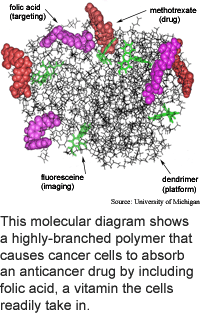
Baited
molecule fights cancer
Many teams of researchers
are working on ways to use nanotechnology to deliver anticancer drugs
directly to cancerous tissue.
Researchers from the University of Michigan have brought the field
a step forward. They showed in live mouse trials that it is possible to
concentrate anticancer drugs in certain tumors by attaching an anticancer
drug and folic acid to tiny bits of polymer and injecting the mix into
the bloodstream.
Key to the method is that the nanoparticles are small enough to
escape the bloodstream and get into cancer cells. The modified dendritic,
or branched, polymers that carry the drugs are less than five nanometers
in diameter. In contrast, a red blood cell is 5,000 nanometers in diameter.
In the researchers' experiments, the nanoparticles and cancer
drug concentrated in tumors after four days. Delivering the drug to the
mice this way increased the antitumor activity of the drug and dramatically
decreased the drug's toxicity, according to the researchers.
The nanoparticles concentrate in cancers that have a high affinity
for folic acid. Brain, breast, endometrium, head, kidney, lung, myeloid,
neck, and ovary cancers all take in a lot of folic acid. Scientists have
chemically linked folic acid to anticancer drugs before, but these previous
methods did not work well because they reduced the effectiveness of the
anticancer drug and reduced the ability of the cancer cells to take up
the folic acid, according to the researchers.
The researchers' method could potentially be used to deliver many
types of therapeutic drugs to nearly any type of cell, according to the
researchers. It could also be used to deliver imaging agents, or substances
that allow certain cells to show up better when medical images are taken.
The method could be ready for testing in humans within 18 months,
and could be through the trials in five to six years, according to the
researchers. The work appeared in the June 15, 2005 issue of Cancer Research
(Nanoparticle Targeting of Anticancer Drug Improves Therapeutic Response
in Animal Model of Human Epithelial Cancer).
Stories:
Traffic model maps congestion
Fingernails store data
Quantum crypto scheme doubly fast
How It Works: Internet Structure
Briefs:
Baited molecule fights cancer
Bacteria drive biochip sensor
System brightens dark video
Micro fuel cell packs power

Research Watch blog
View from the High Ground Q&A
How It Works
RSS Feeds:
News
Ad links:
Buy an ad link
Ad links: Clear History
Buy an ad link
|
TRN
Newswire and Headline Feeds for Web sites
|
© Copyright Technology Research News, LLC 2000-2010. All rights reserved.